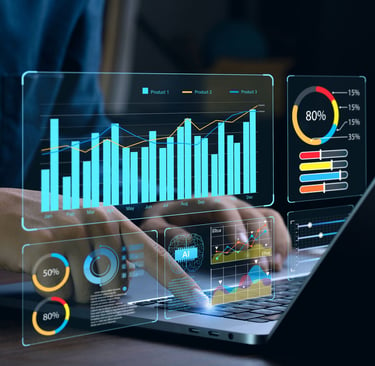Data Visualization
Data visualization and dashboarding empower large organizations to transform complex data into actionable insights. By consolidating information across systems into visual, real-time dashboards, enterprises can enhance decision-making, foster a data-driven culture, and respond swiftly to market changes. Well-designed dashboards support strategic alignment, transparency, and agility — turning data into a true competitive advantage.
11/14/20253 min read


The Strategic Role of Data Visualization and Dashboarding in Enterprise Data Analytics
In today’s competitive and data-centric business environment, large organizations generate and manage unprecedented volumes of information. Yet data in isolation holds little value. The true advantage emerges when organizations can transform data into insights that guide strategic action.
This transformation is made possible through data visualization and dashboarding — foundational components of enterprise data analytics and business intelligence (BI) that convert complex data into clear, actionable information for faster, smarter decision-making.
Transforming Complex Data into Strategic Insight
For large enterprises, data fragmentation across systems, departments, and geographies can make it difficult to obtain a unified view of performance. A corporate data dashboard addresses this challenge by aggregating information from diverse sources into a single, visual interface.
Through dynamic charts, trend lines, and KPIs, dashboards provide an immediate understanding of business performance — allowing executives and managers to:
Identify operational bottlenecks and performance trends
Monitor key financial and operational metrics in real time
Align organizational performance with strategic goals
By converting raw data into visual narratives, business intelligence dashboards empower leaders to interpret complex data quickly and take decisive action.
Fostering a Data-Driven Organizational Culture
One of the most significant benefits of data visualization is its ability to democratize data across the enterprise. When analytics tools are accessible to employees at every level, decision-making becomes both decentralized and data-informed.
A strong data-driven culture ensures that strategic decisions, operational adjustments, and innovation initiatives are grounded in evidence rather than intuition. This not only enhances transparency and accountability but also drives cross-functional collaboration — key attributes of modern, high-performing organizations.
Enabling Executive Decision-Making with Business Intelligence Dashboards
For senior leadership, enterprise dashboards function as a single source of truth for business performance. By integrating financial, operational, and customer data, dashboards enable executives to view real-time performance indicators across business units and regions.
Advanced dashboarding capabilities — such as drill-down analysis and predictive modeling — further enhance decision-making by revealing the underlying drivers of performance. This empowers leaders to:
Forecast risks and opportunities with greater accuracy
Allocate resources effectively based on data-driven insights
Respond proactively to market changes and emerging trends
Through these capabilities, business intelligence solutions become essential instruments of corporate governance and strategic planning.
Enhancing Agility Through Real-Time Data Visualization
In rapidly changing markets, agility is a competitive advantage. Real-time dashboards allow organizations to monitor key metrics continuously and respond immediately to deviations or disruptions.
Examples include
Retail enterprises tracking inventory and sales to optimize product availability
Manufacturers using IoT-integrated dashboards to anticipate equipment maintenance needs
Financial institutions identifying transaction anomalies to strengthen compliance and reduce risk
By enabling real-time situational awareness, data visualization dashboards transform business operations from reactive to proactive.
Best Practices for Designing Effective Enterprise Dashboards
A dashboard’s effectiveness depends on more than just technology — it requires thoughtful design, governance, and alignment with business objectives. Leading organizations adhere to several key design principles:
Strategic Relevance – Each visualization should directly support a corporate objective or KPI.
User-Centric Design – Interfaces should match the technical proficiency and informational needs of end users.
Visual Clarity and Consistency – Simplicity, clean layouts, and standard color schemes enhance readability.
Scalability and Integration – Dashboards should integrate seamlessly with enterprise systems and data warehouses.
Interactivity – Filters, drill-downs, and alerts allow users to explore insights at multiple levels of detail.
Modern business intelligence platforms such as Microsoft Power BI, Tableau, Looker, and Qlik facilitate the development of scalable, secure, and interactive dashboards that align with corporate analytics strategies.
Conclusion: The Competitive Advantage of Data Visualization
For large organizations, data visualization and dashboarding are not merely reporting tools — they are strategic enablers of transformation. By converting data into insight, they bridge the gap between information and action, empowering leaders to make informed, timely, and confident decisions.
In an increasingly digital economy, the ability to visualize, interpret, and act on data effectively is what distinguishes innovative, agile organizations from their competitors.
Enterprises that invest in data visualization and business intelligence today are building the foundation for smarter, more responsive, and more resilient operations tomorrow.
© 2025. All rights reserved.
